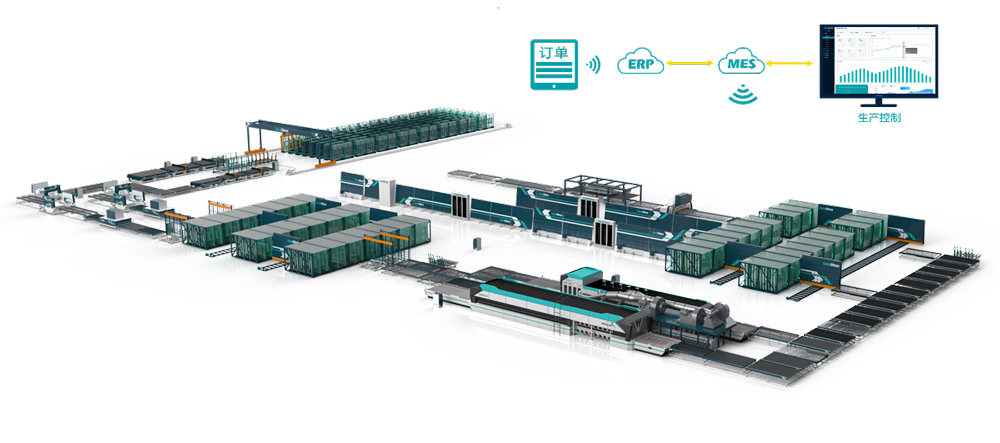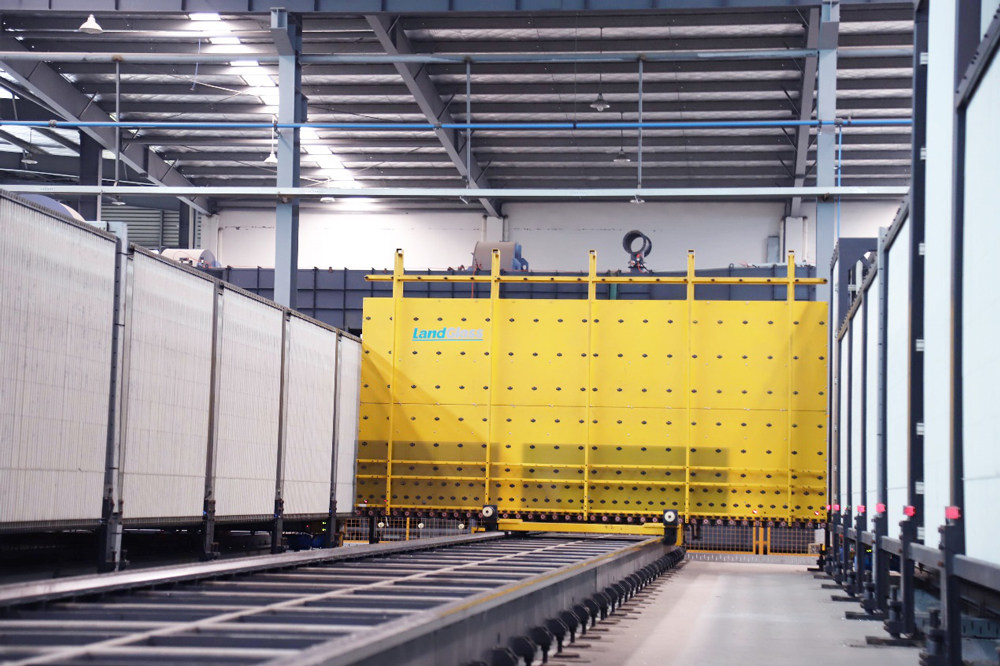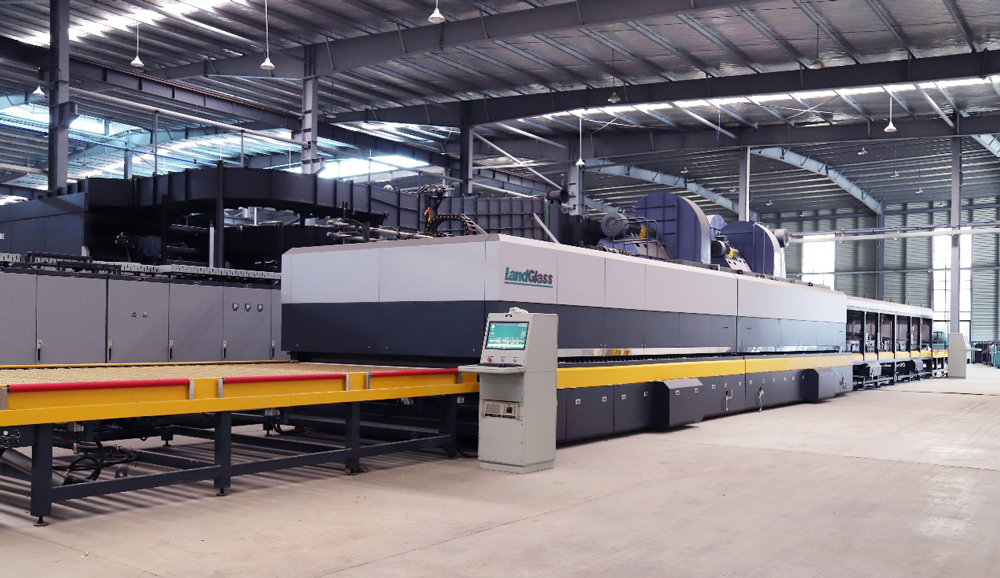The global trend towards intelligent manufacturing and smart factories is changing the production and business models in many industries. The glass processing industry is no exception. While the industry is overwhelmed with different types of smart factory concepts, LandGlass has summarized its knowledge and experience in design and construction of smart factory to help you understand smart factory and successfully meet the challenges of intelligence.

1. An intelligent glass processing factory is by no means a collection of physically connected processing machine.
Some business owners believe that connecting a number of main units through conveyors makes a smart factory. However, the real production in this mechanically connected setting will encounter numerous problems. The reason is that such thought has overlooked the essence of the smart factory: the production pace. Each main processing machine has its own pace. It requires professional design and planning along with the overall coordination by ERP and MES systems to achieve real intelligent production.
2.The amount of investment required in the intelligent glass processing factory depends on the production mode you choose
Your production scale, types of products, and number of production shifts will all be the factors that have an impact on your total investment cost in an intelligent factory. Taking the investment cost of a buffer system as an example, in a continuous production mode, the buffer system will also be in a continuous circulation state and does not require large storage capacity. If the enterprise takes advantage of the electricity tiered pricing plan by scheduling cold processing in the daytime and tempering operation in the nighttime, then, a pre-tempering buffer system with a capacity larger than the cold processing output should be considered when designing the smart factory. Accordingly, the investment cost in the buffer system is bound to increase.

3. How low can the energy consumption of an intelligent glass processing plant go?
Compared to traditional factories, due to the addition of the buffer system and the production line conveyor system, the electricity consumption will slightly increase. According to the field measurements done by LandGlass at customers’ factories, the electricity consumption cost for an intelligent building glass factory with an annual production capacity of 800,000 to 1,000,000 yuan output will be 200-300 yuan/hour higher than a traditional factory. However, the improvement in productivity, yield of sizing, and loading capacity lead to the decrease of machine operation time, saving up to 2-2.5 million yuan in annual electricity costs.
4.Are humans still needed in a smart factory?
In a smart factory, there are still plenty of areas where humans are necessary. The number of workers may decrease but the requirement for their skills will increase. According to LandGlass’ field measurements at customer’s building glass smart factory with an annual production capacity of 800,000-1,000,000 yuan output, the number of workers decreases by 15-20 people in comparison with a traditional factory due to the elimination of needs for workers who perform repetitive works in the loading and transporting sections. In the meantime, as the production is mainly coordinated by the information systems (ERP, MES, SCADA), normal process requires no human intervention. One person can manage several machines at the same time.
5. An intelligent glass processing factory does not take up additional floor space
For the same output, an intelligent factory occupies about the same floor area as a traditional factory. By using buffer system and production line conveyor system to replace the loading/unloading units in various processing stages and the temporary storage zone between processes, the overall footprint of the system remains unchanged. In addition, it eliminates the hassle of locating and handling.
6.The process layout of an intelligent glass processing factory cannot be simply copied
In principle, the design of a smart factory follows the product processes, makes rational use and configuration of automation equipment to connect the main processing machines for a coordinated operation. However, the actual design will take into consideration the customer’s product portfolio, product characteristics, sales model (domestic or export sales), capacity requirements, power load, and a number of other factors. Therefore, it can be said that each smart factory is unique in design.
7.The existing glass processing factory can undergo upgrade without interruption to the production
For an intelligent upgrade and transformation of a traditional glass processing plant, as long as the existing machines are not required to move their positions in the transformation plan and safety is warranted, the upgrade can be carried out without interrupting the current production activities.

8.The glass tempering furnace is the core production pace in an intelligent glass processing factory
In a glass processing plant, the installed power of a glass tempering furnace accounts for half of the plant power. When designing the process of a smart factory, you need to make a reasonable choice of the equipment capacity configuration according to your capacity planning and product portfolio, especially the capacity configuration of the tempering furnace to ensure the flexibility of the production organization. LandGlass’ field measurements indicate that for a building glass smart factory with an annual production capacity of 800,000-1,000,000 yuan output and equipped with our 2800mm×5000mm combined glass tempering furnace, when it runs at full capacity to produce 6mm float glass at a 23-25 loads/hour, the factory can save up to 500,000-1,000,000 yuan electricity cost compared with a traditional plant due to enhanced productivity.
9.Can a glass processing smart factory run without a buffer system ?
Definitely. However, it is only suitable for high-volume production orders with a single set of specifications. If there are many different specifications in the production order, a buffer system will lower your production costs. According to LandGlass' years of experience in the industry, in the absence of a buffer system, the furnace can only process production orders with a single set of specifications, one at a time. The yield of sizing ranges from 82% to 88%. When the machine is equipped with a buffer system, it will be able to handle multi-specification production orders with a yield of sizing from 88% to 95%, resulting in significant savings in the cost of glass sheets. In addition, a buffer system can also improve the efficiency of the production line. Equipment such as the edge grinding machine and other devices no longer require frequent adjustments. Therefore, whether you need a buffer system or not, it really depends on the factory's product portfolio, product types, and the capacity needs.
10.Laser marking vs labeling
A good product marking system will allow you to identify and trace the products more easily throughout the entire production process, making it more efficient to replace the glass breakage. Laser marking is durable in high temperature and lasts much longer. On the other hand, paper labels provide good readability in water. Therefore, make a reasonable choice of laser marking or paper label according to the characteristics of your production process. With the development of intelligent industry, laser marking is bound to be the trend in the glass processing industry as it provides permanent traceability.